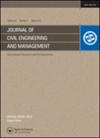台湾公立学校建筑工程进度与性价比预测
IF 3.7
3区 工程技术
Q1 ENGINEERING, CIVIL
引用次数: 0
摘要
台湾教育部(MOE)每年在公立学校建设项目(PSBPs)上投资约300亿新台币。然而,95%的psbp已经延长,并产生了增加的成本。采用模糊德尔菲法(FDM)、关联规则和人工神经网络(ANN)建立了PSBP性能评价与预测系统。本研究以62家台湾民营企业为样本,定义了影响民营企业项目绩效的11个高相关因素,并探讨了导致民营企业项目绩效不佳的原因。此外,由人工神经网络操作的测试用例的结果表明,进度和成本可变性预测的准确率可以达到84%。较高的准确率表明了未来对高风险项目进行优先级控制的可靠性。建议的方法可以提供给客户、设计和施工公司以及项目经理实时了解项目绩效,并建立动态跟踪审查和响应措施,以提高项目的整体满意度。本文章由计算机程序翻译,如有差异,请以英文原文为准。
PREDICTING THE SCHEDULE AND COST PERFORMANCE IN PUBLIC SCHOOL BUILDING PROJECTS IN TAIWAN
The Ministry of Education (MOE) of Taiwan invests about NTD 30 billion a year in Public School Building Projects (PSBPs). However, 95% of the PSBPs have been extended and have incurred increased costs. A PSBP performance evaluation and prediction system was established by using the Fuzzy Delphi Method (FDM), association rules and an Artificial Neural Network (ANN). Sixty-two Taiwanese PSBPs were used as the samples, while eleven high correlation factors that influence the project performance of PSBPs were defined, and the reasons leading to the poor project performance were discussed in this study. Moreover, the results of the test cases operated by ANN showed that the accuracy rate for schedule and cost variability predictions can reach 84%. The high accuracy rate indicated the reliability of priority control for high-risk projects in the future. The proposed approach can be provided to clients, design and construction firms, and project managers to understand the project performance in real time and to establish a dynamic tracking review and response measures for improving the overall project satisfaction.
求助全文
通过发布文献求助,成功后即可免费获取论文全文。
去求助
来源期刊

Journal of Civil Engineering and Management
ENGINEERING, CIVIL-
CiteScore
6.70
自引率
4.70%
发文量
0
审稿时长
1.7 months
期刊介绍:
The Journal of Civil Engineering and Management is a peer-reviewed journal that provides an international forum for the dissemination of the latest original research, achievements and developments. We publish for researchers, designers, users and manufacturers in the different fields of civil engineering and management.
The journal publishes original articles that present new information and reviews. Our objective is to provide essential information and new ideas to help improve civil engineering competency, efficiency and productivity in world markets.
The Journal of Civil Engineering and Management publishes articles in the following fields:
building materials and structures,
structural mechanics and physics,
geotechnical engineering,
road and bridge engineering,
urban engineering and economy,
constructions technology, economy and management,
information technologies in construction,
fire protection, thermoinsulation and renovation of buildings,
labour safety in construction.
 求助内容:
求助内容: 应助结果提醒方式:
应助结果提醒方式:


